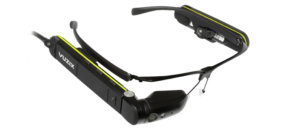13 Smart Glasses For Augmented Reality (Updated)
Table of contents

In the past, we’ve covered several companies developing smart glasses for augmented reality (AR) and discussed the exciting ways that AR technology is being used to enhance everyday life. Since Google first announced their Google Glass project and gave us a glimpse of how the technology could change the way that we interact with the world around us, smart glasses have caught the attention of the industry at large. Today, there are many companies developing augmented reality smart glasses, each at different stages of the product development process.
Here is a complete list of all the need-to-know smart glass companies to keep an eye on:
Microsoft Hololens
In January 2015, Microsoft announced their augmented reality smart glasses project, the Microsoft Hololens. Currently, the company only offers Development Edition ($3,000) and Commercial Suite ($5,000).

A recent eye-tracking patent filing by the company suggests that future versions of the Hololens may include the technology, which uses waveguides and infrared to track eye movement. The speculation has been that the patent could be used in Microsoft’s attempt find a solution to compatibility issues with prescription eyewear.
The company has been deliberately coy regarding the potential release timeline of the HoloLens. In a January 2015 interview with BBC, Microsoft CEO Satya Nadella said that she saw the HoloLens project as a “five year journey,” but has made no further comments on potential release timelines. It is clear, however, that Microsoft will first focus on developmental releases and enterprise applications before setting their sights on a commercial HoloLens launch.
Update 07/12/2018: Microsoft is reportedly eyeing to release Hololens 2 in 2019, and planning to shift from an Intel Chipset to Qualcomm’s XR1.
ODG R-7
Osterhout Design Group’s (ODG) R-7 smart glasses have been impressive enough to help the company secure $58 million in Series A funding. The smart augmented reality glasses feature a Qualcomm Snapdragon 805 2.7 GHz Quad-core Processor.

ODG has set their sights on the enterprise market, having already partnered with companies like Advanced Medical Applications, Atheer, NuEyes, and Vital Enterprises to bring their glasses to the manufacturing, medical, transportation, and logistics industries.
Update 07/12/2018: ODG announced last April the latest addition to their product line called SAVED™ (Smoke Assured Vision Enhanced Display) which is reportedly the first heads-up display (HUD) oxygen mask that incorporates the company’s award-winning technology to aid pilots in emergency lands in case the cockpit gets filled with smoke.
Sony SmartEyeGlass
Sony has been a leading company in the virtual reality industry, and have turned their attention toward augmented reality as well. In early 2015 the company released the Developer Edition of the Sony SmartEyeGlass, an augmented reality smart glasses device that was the company’s answer to Google Glass. The SmartEyeGlass includes a gyroscope, ambient light sensor, and built in camera.
Sony also offers a development edition of the SmartEyeGlass Attach, a product that is designed to bring smart features to typical prescription eyeglasses by attaching to the legs, featuring a 0.23 inch OLED display, 640 x 400 resolution and ARM processor. The company has been tight-lipped regarding potential release windows but are not expected to release their own smart devices anytime soon.
Vuzix M300
We wrote about Vuzix in September. The company was founded in 1997, focusing on the earliest applications of virtual reality. Vuzix debuted their initial public offering in 2010, and refocused their company in 2012 away from defense markets to consumer entertainment and enterprise.
Their augmented reality glasses, the VuzixM300, feature an Intel Atom processor and run Android 6.0. Vuzix is targeting enterprise applications for the M300, but is not ruling out a consumer-centric version of the product. The M300 will cost $1,499.
Update 07/12/2018: Vuzix recently announced partnership with Plessey MicroLED technology in developing their next-generation AR smart glasses, looking to use a more energy-efficient light engine for better display and improved battery life.
Jins Meme ES & MT
Based in Tokyo, Jins first announced and demoed their smart glasses in 2015. The company wanted to create smart glasses that didn’t sacrifice fashion and functionality, while still delivering advanced features.

Jins has placed a lot of focus on developing the Meme as an academic resource, creating applications and adding features specifically for educational settings. The company has released two versions of the glasses, the Jins Meme ES, and Jins Meme MT, each coming with its own set of apps. Jins Meme smart glasses feature apps that are designed for specific activities such as walking, running, driving, and office work. Currently, the apps only work in Japan and anyone outside of Japan must apply to purchase a pair.
Update 07/12/2018: Since Jins’s expansion to the US in Los Angeles and San Francisco Bay Area in 2015, Jins Meme also recently released 3 apps to improve concentration at work, at home or when on a walk through the help of their glasses’ sensors.
Recon Jet Smart Eyewear
One of the most commonly cited use cases for smart glasses is for athletic performance tracking and training, which is exactly what the Recon Jet provides. The glasses are designed to fit securely on the face while walking, running, or biking. The glasses feature a 1 GHz dual-core ARM Cortex-A9 CPU, 1 GB SDRAM, accelerometer, gyroscope, magnetometer and pressure sensor, along with a widescreen 16:9 WQVGA display.

While exercising or playing sports, the glasses display information such as your current speed, distance traveled, current time, GPS information and other metrics that athletes would find useful. The Recon Jet is offered in several different styles and is available today for $499.
Update 07/12/2018: After Intel’s acquisition of Recon Instruments in 2015, it’s been closed down since October 2017. While reports state that Intel is working on some new secret AR smart glasses, it’s still unclear if it’s going to be under the Recon branding.
CastAR (Discontinued)


CastAR was designed for the gaming market and hope to launch their device with “around 10 hours of entertainment ready-to-go” when the device goes on sale. Although the company has not announced a release date at this time, they have targeted a 2017 launch.
UPDATE 07/12/2018: Unfortunately, CastAR was reportedly unable to receive more funding from their present backers or any new companies and officially went out of business June of last year.
Epson Moverio


Update 07/12/2018: Epson announced, last May 30, in Augmented World Expo 2018 (AWE 2018) the release of an AR software development kit optimized for Moverio AR smart glasses for developers to create AR content and applications. One application they’re being used for is DJI drones. You can pick up a set on Amazon for $699 right now.
Meta 2


The Meta 2 stands out from other augmented reality smart glasses devices with it’s powerful specs. It features an Intel Core i7 CPU that is traditionally used for desktop PCs. It also offers 8 GB RAM, NVIDIA GTX 960 / AMD R9 280 graphics, and a 2550 x 1440 resolution with an impressive 90-degree field of view.
Meta has focused primarily on enterprise applications and now boasts a list of more than 1,000 developers and partnered companies currently using the device. You can buy the Meta 2 development kit today for $949.
Update 07/12/2018: After demonstrating at CES 2018 the massive haptic/touch updates for Meta 2 wherein users can basically feel holograms January of this year, the company also announced a partnership with Dell to sell their software development kit.
LaForge Shima


Designed to be stylish, lightweight, and strong, the glasses feature a display that delivers notifications from smartphone apps directly to your field of vision. The LaForge Shima does not allow users to control the apps or interface with features directly through the glasses, and instead acts as a visual notification system, allowing users to be alerted to new calls, text messages, and drive with in-vision directions directly on the display.
Update 07/12/2018: LaForge has been conducting tests for their ongoing product updates codenamed Shima Alpha, Beta, and Beta Bold to test the health implications of their product and the social implications for the wearers and those around them.
Optinvent ORA-2
Optinvent was founded in 2007 and is a company that focuses on disruptive near-to-eye projection displays and wearable tech. They are the developers of the ORA-2 Professional Smart Glass platform, smart glasses that run Android and feature a transparent retinal projection technology that provides a crisp display.

The company has focused primarily on enterprise solutions, specifically targeting the manufacturing and logistics industries. The Ora-2 features a dual-core processor, camera, microphone, Bluetooth and GPS. Currently, the ORA-2 offers a number of applications that include location-based services, maintenance, logistics, messaging, and situational awareness. You can buy the Optinvent Ora-2 today for around $725.
Update 07/12/2018: Optinvent recently announced a partnership with Crunchfish, a software developer for AR and VR, to bring touchless gesture control to their AR smart glasses.
GlassUp UNO & Factory 4.0
GlassUp is an augmented reality wearables company that is currently developing two lines of smart glasses for commercial and enterprise applications – the UNO and Factory 4.0. The GlassUp Uno uses Bluetooth to connect with your smartphone and translate information and notifications to their augmented reality display at a high resolution.

Update 07/12/2018: Apart from recent feature updates to Factory 4.0 such as danger detection and image recognition, GlassUp also added a teleservices application wherein remote operators can now see the point of view of on-machine workers.
Atheer AiR Glasses
Atheer is an augmented reality smart glasses company that has focused on creating enterprise-ready wearable devices for field engineers and deskless workers.

The Atheer AiR Glasses are powered by Android, offer 3D gesture interaction, and boast an 8 hour battery life, allowing field workers to use them for a full shift. The company is currently partnered with Vuzix for hardware, but are transitioning into developing their own smart glasses.
Update 07/12/2018: Last March, Atheer announced their partnership with Toshiba to offer enterprise-grade AR software platform for Toshiba’s newly released dynaEdge ™ AR smart glasses to be used in industrial applications such as field service, dealer service, assembly line management and many more.
Conclusion
Although we have yet to see the world set ablaze by wearable smart glasses, products like the ones mentioned in this article are a stepping stone to commercial and enterprise applications. Investors will want to keep an eye on these augmented reality smart glasses companies as we enter 2017 to see which ones start to establish meaningful market share.
Sign up to our newsletter to get more of our great research delivered straight to your inbox!
Nanalyze Weekly includes useful insights written by our team of underpaid MBAs, research on new disruptive technology stocks flying under the radar, and summaries of our recent research. Always 100% free.
















